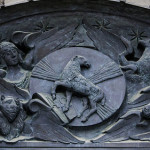We run our website the way we wished the whole internet worked: we provide high quality original content with no ads. We are funded solely by your direct support. Please consider supporting this project.

Reflections on the Supremacy of Christ (Part 2)
Whereas most Christians place the revelation of God in Christ alongside of other portraits of God and end up with an amalgamated image of God, we at ReKnew encourage believers to base their understanding of God completely on Christ, and especially on Christ crucified. And we encourage disciples to work to reinterpret through the lens of the cross every image of God in Scripture that conflicts with it. This is what I am seeking to accomplish in my forthcoming book, The Crucifixion of the Warrior God: Reinterpreting the Old Testament’s Violent Divine Portraits in Light of the Cross (IVP). (By the way, I am aiming at completing this work by the end of this year, which would probably mean that it would be published late 2013 or early 2014.)
I find myself in agreement with Dieter Georgi when he notes that the revelation of God on the cross was for Paul and the communities he pastored “more than a shift in their understanding of themselves and of God.” With this revelation, “[t]he very essence of the matter is changed: it is God who has been transformed.”[1] In fact, in relation to what was revealed about God in the Old Testament, Georgi goes so far as to contend that the revelation of God in the crucified Christ “stands God on the head.”[2]
My claim is that the New Testament itself sets the precedent for placing the revelation of God in the crucified Christ over, instead of alongside of, other images of God in Scripture. I shared the first Reflection of the Supremacy of Christ in my previous post. I will now share a second.
The author of Hebrews opens the Epistle by saying:
In the past, God spoke to our ancestors through the prophets at many times and in various ways. But in these last days he has spoken to us by his Son….The Son is the radiance of God’s glory and the exact representation of his being…(Heb 1:1-3).
While this author acknowledges that God spoke in a variety of ways in the past, he also emphasizes that the revelation of God in Jesus supersedes these past revelations. Unlike past revelations that were mediated through prophets, Jesus is God’s own Son. The author is essentially saying that the revelation of God in his Son contrasts with the “various ways” God was revealed in the past because in the Son we finally have God in person.
So too, while Old Testament writings may reflect aspects of God’s glory, this author says that the Son alone reflects the “radiance of God’s glory.” To grasp his point, we could say that “radiance” (apaugasma) is to “glory” (doxa) what light is to the sun. When God’s glory is manifested, the author is saying, it looks like Jesus. Every previous reflection of God’s glory, by contrast, was a mere approximation.
Along the same lines, while Old Testament writings may capture glimpses of what God is like, the author of Hebrews proclaims that the Son alone is God’s exact representation. The Greek word translated “representation” (characktēr) refers to a stamp, carving or image. The author is thus saying that in the Son alone we discover exactly what God is like. Paul’s teaching that Jesus is the one true image (iconos) of God says the same thing (2 Cor 4:4).
And, most importantly, this “representation” reveals exactly what God is like in his very “being.” The Greek word translated “being” (hypostasis) refers to the essence or substance of something. This author is thus teaching us that, while previous revelations may reflect approximations of God’s attributes or of what God is like in his activity, the Son alone reveals exactly what God is like in his very essence, in his innermost heart, or in his eternal nature. The Son thus sums up, and supersedes, all that was true about previous revelations.
Whatever you make of the sometimes horrifically violent portraits of God in the Old Testament, I strongly encourage you to not fuse these with what you learn about God’s character in Christ. Fix your eyes on Jesus, as this author says (Heb 12:2). Trust that the perfect, other-oriented, self-sacrificial love that is revealed on Calvary displays the full beauty of exactly what God is like to the very core of his being.
[1] D. Georgi, Theocracy in Paul’s Praxis and Theology (Minneapolis: Fortress, 1991), 20.
[2] Georgi, ibid., 54.
Image by D. Sharon Pruitt. Sourced via Flickr.
Category: General
Tags: Bible, Cruciform Theology, Jesus, ReKnew
Related Reading

Jesus: Our Vision of God
At the beginning of his Gospel John taught that “no one has ever seen God, but the one and only Son, who is himself God and is in closest relationship with the Father, has made him known” (Jn 1:18). He is claiming that, outside of Christ, no one has ever truly known God. In the…

God and Our Political Platforms
Rachel Held Evans posted a blog today on the stir created when Democrats booed the passing of “an amendment to the party platform reinstating language that identified Jerusalem as the rightful capital of Israel and that referred to people’s “God-given potential” in its preamble.” Of course this fed into the belief that if you’re a…

How To Fix The Church: The Kingdom of God (Part 4)
God has leveraged everything on the Church loving like Jesus loved, as outlined in our previous posts in this series. “By this the world will know you are my disciples,” Jesus said, “by your love” (Jn 13:35). By God’s own design, Christ-like love is supposed to be the proof that Jesus is real. In John…

God Became a Zygote
Has the Christmas story become so familiar that you’ve lost any sense of how spectacular it is? The great creator of the universe became a microscopic zygote. The all-powerful being who spoke the stars into existence came in a very small and vulnerable way. He crossed an infinite distance to become one of us. You can watch…

The Warfare We Have Inherited
Image by Chris Sardegna Jesus’ miracles over nature, as well as his healings, exorcisms and especially his resurrection, were definite acts of war that accomplished and demonstrated his victory over Satan. These acts routed demonic forces and thereby established the kingdom of God in people’s lives and in nature. But their primary significance was eschatological. People…

The Final Battle in Revelation
I will conclude this series on the violent imagery in Revelation by addressing the infamous eschatological battle scene found in 19:11-21, for it is this graphically violent section of Revelation that is most frequently appealed to by those who argue against the claim that Jesus reveals an enemy-loving, non-violent God that is unconditionally opposed to…
